transformer
https://www.cnblogs.com/zingp/p/11696111.html
阅读目录
- 1 模型的思想
- 2 模型的架构
- 3 Embedding
- 3.1 Word Embedding
- 3.2 Positional Embedding
- 4 Encoder
- 4.1 Muti-Head-Attention
- 4.1.1 Self-Attention
- 4.1.2 Add & Norm
- 4.2 Feed-Forward Network
- 5 Decoder
- 5.1 Mask-Multi-Head-Attention
- 5.2 Encoder-Decoder Multi-head Attention
- 5.3 Linear and Softmax to Produce Output Probabilities
- 6 Transformer的优缺点
- 6.1 优点
- 6.2 缺点
- 7 References
1 模型的思想
Transformer中抛弃了传统的CNN和RNN,整个网络结构完全是由Attention机制组成。 作者采用Attention机制的原因是考虑到RNN(或者LSTM,GRU等)的计算是顺序的,RNN相关算法只能从左向右依次计算或者从右向左依次计算,这种机制带来了两个问题:
Transformer的提出解决了上面两个问题:
2 模型的架构
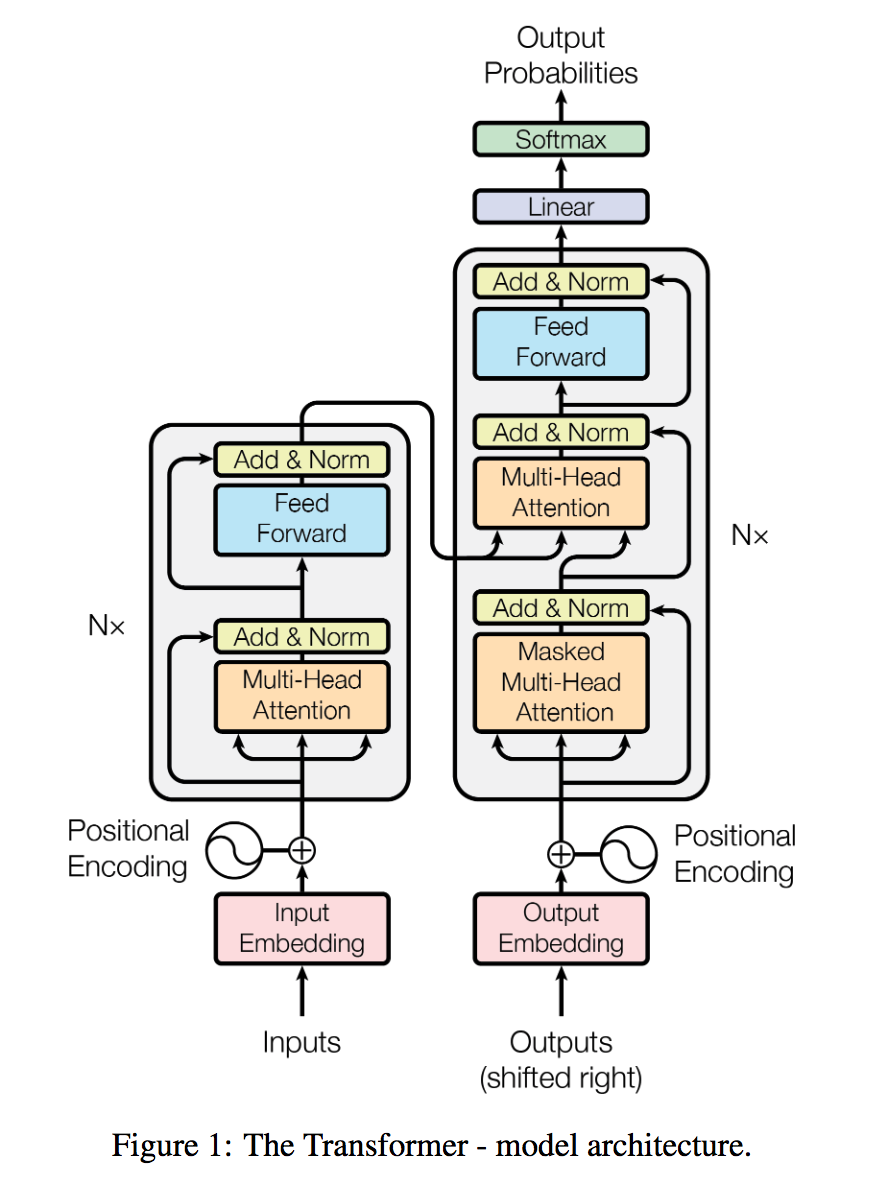
如上图,transformer模型本质上是一个Encoder-Decoder的结构。输入序列先进行Embedding,经过Encoder之后结合上一次output再输入Decoder,最后用softmax计算序列下一个单词的概率。
3 Embedding
transformer的输入是Word Embedding + Position Embedding。
3.1 Word Embedding
|
1
2
3
4
5
6
7
8
|
class Embeddings(nn.Module): def __init__(self, d_model, vocab): super(Embeddings, self).__init__() self.lut = nn.Embedding(vocab, d_model) self.d_model = d_model #表示embedding的维度 def forward(self, x): return self.lut(x) * math.sqrt(self.d_model) |
3.2 Positional Embedding
在RNN中,对句子的处理是一个个word按顺序输入的。但在 Transformer 中,输入句子的所有word是同时处理的,没有考虑词的排序和位置信息。因此,Transformer 的作者提出了加入 “positional encoding” 的方法来解决这个问题。“positional encoding“”使得 Transformer 可以衡量 word 位置有关的信息。
如何实现具有位置信息的encoding呢?作者提供了两种思路:
- 通过训练学习 positional encoding 向量;
- 使用公式来计算 positional encoding向量。
试验后发现两种选择的结果是相似的,所以采用了第2种方法,优点是不需要训练参数,而且即使在训练集中没有出现过的句子长度上也能用。
|
1
2
3
4
5
6
7
8
9
10
11
12
13
14
15
16
17
18
19
20
|
# Positional Encodingclass PositionalEncoding(nn.Module): "实现PE功能" def __init__(self, d_model, dropout, max_len=5000): super(PositionalEncoding, self).__init__() self.dropout = nn.Dropout(p=dropout) pe = torch.zeros(max_len, d_model) position = torch.arange(0., max_len).unsqueeze(1) div_term = torch.exp(torch.arange(0., d_model, 2) * -(math.log(10000.0) / d_model)) pe[:, 0::2] = torch.sin(position * div_term) # 偶数列 pe[:, 1::2] = torch.cos(position * div_term) # 奇数列 pe = pe.unsqueeze(0) # [1, max_len, d_model] self.register_buffer('pe', pe) def forward(self, x): x = x + Variable(self.pe[:, :x.size(1)], requires_grad=False) return self.dropout(x) |
|
1
2
3
4
5
6
|
# 在位置编码下方,将基于位置添加正弦波。对于每个维度,波的频率和偏移都不同。plt.figure(figsize=(15, 5))pe = PositionalEncoding(20, 0)y = pe.forward(Variable(torch.zeros(1, 100, 20)))plt.plot(np.arange(100), y[0, :, 4:8].data.numpy())plt.legend(["dim %d"%p for p in [4,5,6,7]]) |
输出图像:

可以看到某个序列中不同位置的单词,在某一维度上的位置编码数值不一样,即同一序列的不同单词在单个纬度符合某个正弦或者余弦,可认为他们的具有相对关系。
4 Encoder
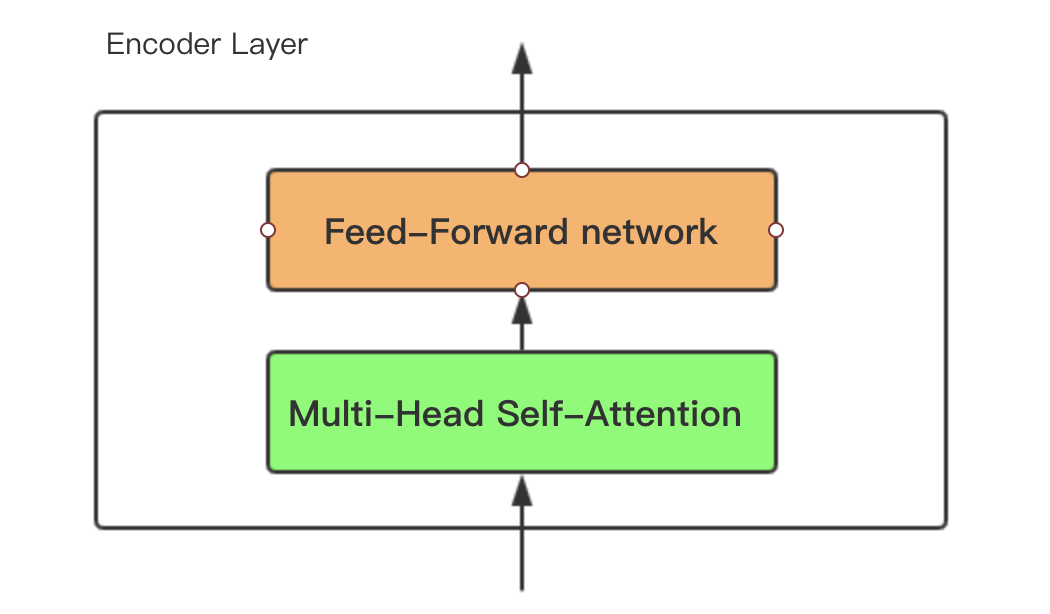
4.1 Muti-Head-Attention
4.1.1 Self-Attention
key(K), x经过第三个线性变换得到value(V)。- key = linear_k(x)
- query = linear_q(x)
- value = linear_v(x)
用矩阵表示即:
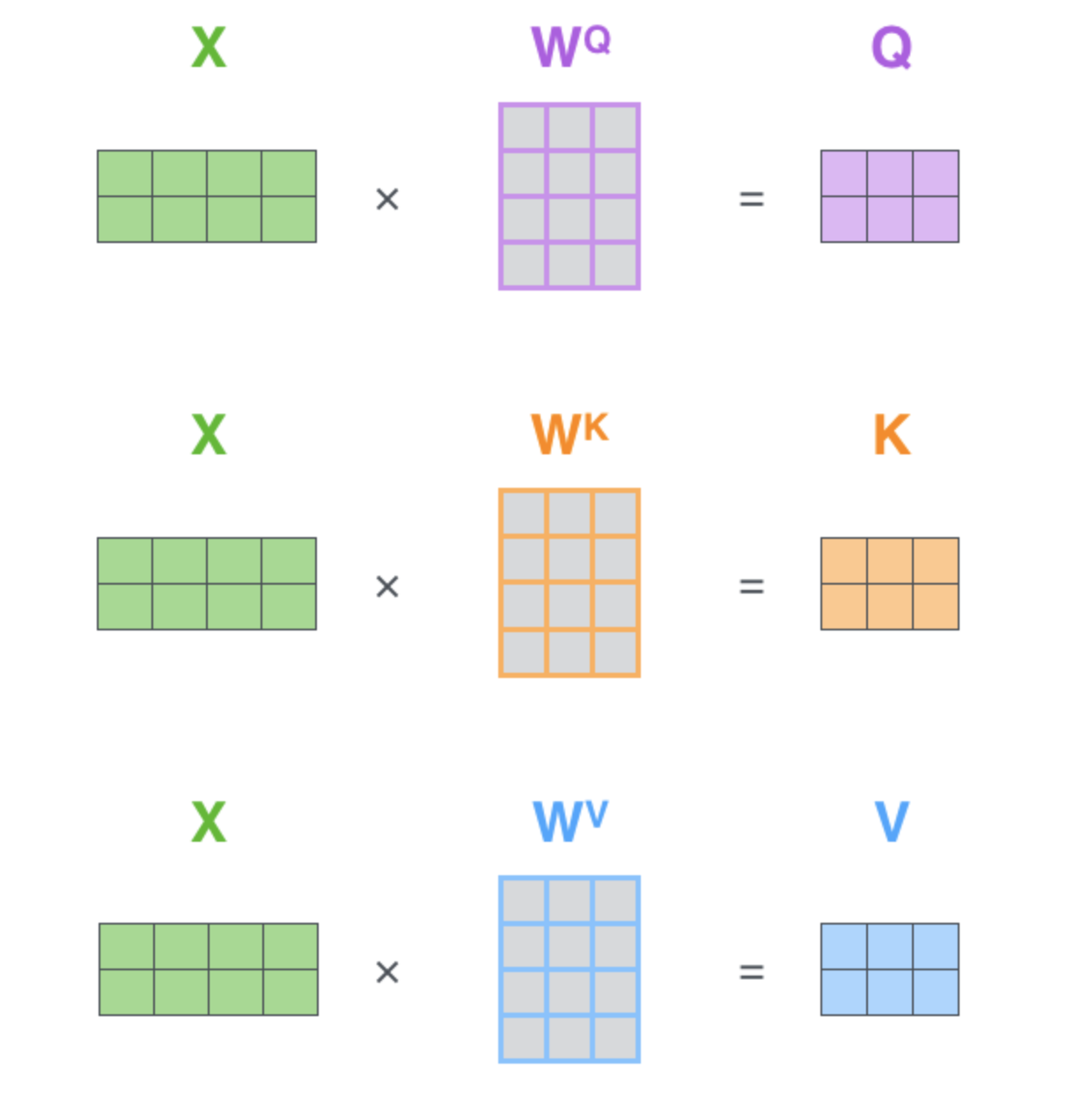
注意:这里的linear_k, linear_q, linear_v是相互独立、权重(WQWQ, WKWK, $W^V$)是不同的,通过训练可得到。得到query(Q),key(K),value(V)之后按照下面的公式计算attention(Q, K, V):
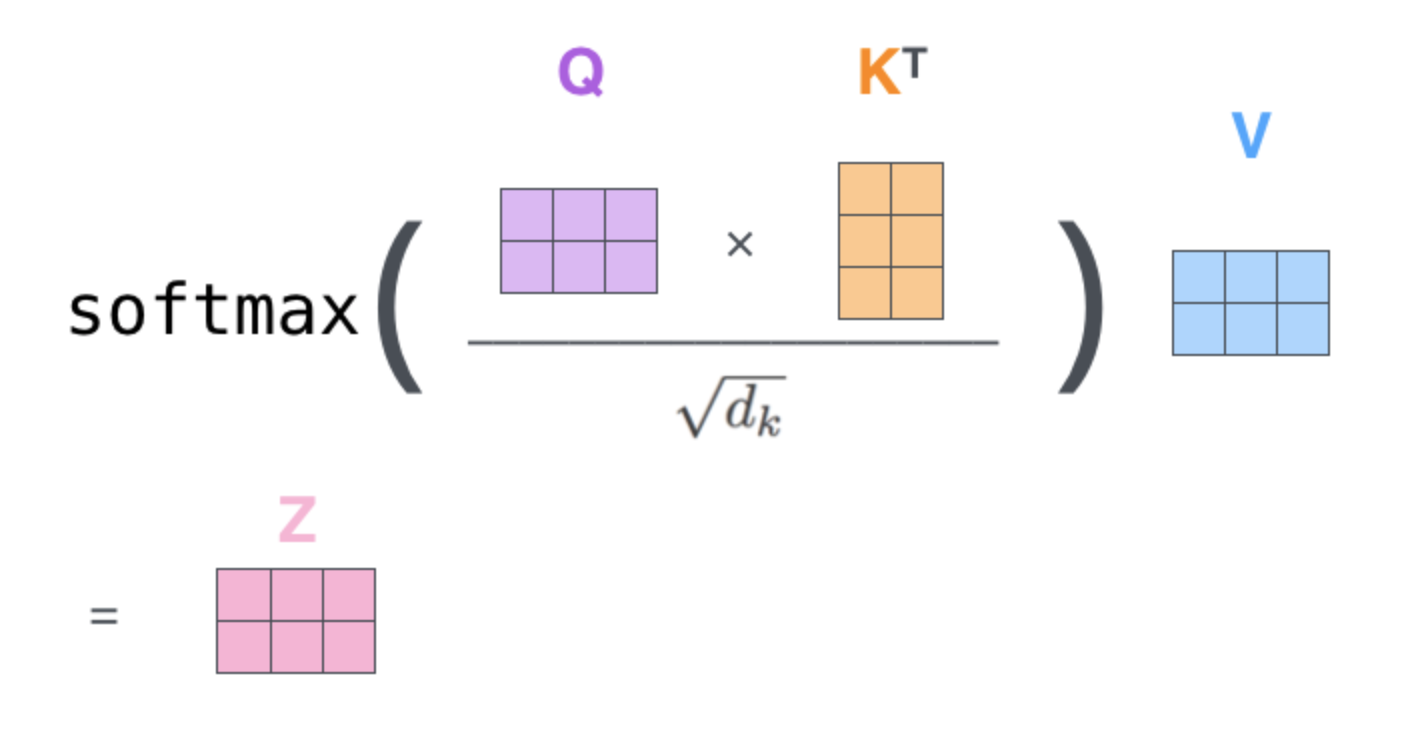
这里Z就是attention(Q, K, V)。
(1) 这里dk=dmodel/h=512/8=64dk=dmodel/h=512/8=64。
(2) 为什么要用dk−−√dk 对 QKTQKT进行缩放呢?
dkdk实际上是Q/K/V的最后一个维度,当dkdk越大,QKTQKT就越大,可能会将softmax函数推入梯度极小的区域。
(3) softmax之后值都介于0到1之间,可以理解成得到了 attention weights。然后基于这个 attention weights 对 V 求 weighted sum 值 Attention(Q, K, V)。
Multi-Head-Attention 就是将embedding之后的X按维度dmodel=512dmodel=512 切割成h=8h=8个,分别做self-attention之后再合并在一起。
源码如下:
|
1
2
3
4
5
6
7
8
9
10
11
12
13
14
15
16
17
18
19
20
21
22
23
24
25
26
27
28
29
30
31
32
33
34
|
class MultiHeadedAttention(nn.Module): def __init__(self, h, d_model, dropout=0.1): "Take in model size and number of heads." super(MultiHeadedAttention, self).__init__() assert d_model % h == 0 self.d_k = d_model // h self.h = h self.linears = clones(nn.Linear(d_model, d_model), 4) self.attn = None self.dropout = nn.Dropout(p=dropout) def forward(self, query, key, value, mask=None): """ 实现MultiHeadedAttention。 输入的q,k,v是形状 [batch, L, d_model]。 输出的x 的形状同上。 """ if mask is not None: # Same mask applied to all h heads. mask = mask.unsqueeze(1) nbatches = query.size(0) # 1) 这一步qkv变化:[batch, L, d_model] ->[batch, h, L, d_model/h] query, key, value = \ [l(x).view(nbatches, -1, self.h, self.d_k).transpose(1, 2) for l, x in zip(self.linears, (query, key, value))] # 2) 计算注意力attn 得到attn*v 与attn # qkv :[batch, h, L, d_model/h] -->x:[b, h, L, d_model/h], attn[b, h, L, L] x, self.attn = attention(query, key, value, mask=mask, dropout=self.dropout) # 3) 上一步的结果合并在一起还原成原始输入序列的形状 x = x.transpose(1, 2).contiguous().view(nbatches, -1, self.h * self.d_k) # 最后再过一个线性层 return self.linears[-1](x) |
4.1.2 Add & Norm
|
1
2
3
4
5
6
7
8
9
10
11
12
13
14
15
16
17
18
19
20
21
22
23
24
25
|
class LayerNorm(nn.Module): """构造一个layernorm模块""" def __init__(self, features, eps=1e-6): super(LayerNorm, self).__init__() self.a_2 = nn.Parameter(torch.ones(features)) self.b_2 = nn.Parameter(torch.zeros(features)) self.eps = eps def forward(self, x): "Norm" mean = x.mean(-1, keepdim=True) std = x.std(-1, keepdim=True) return self.a_2 * (x - mean) / (std + self.eps) + self.b_2class SublayerConnection(nn.Module): """Add+Norm""" def __init__(self, size, dropout): super(SublayerConnection, self).__init__() self.norm = LayerNorm(size) self.dropout = nn.Dropout(dropout) def forward(self, x, sublayer): "add norm" return x + self.dropout(sublayer(self.norm(x))) |
注意:几乎每个sub layer之后都会经过一个归一化,然后再加在原来的输入上。这里叫残余连接。
4.2 Feed-Forward Network
|
1
2
3
4
5
6
7
8
9
10
11
|
# Position-wise Feed-Forward Networksclass PositionwiseFeedForward(nn.Module): "实现FFN函数" def __init__(self, d_model, d_ff, dropout=0.1): super(PositionwiseFeedForward, self).__init__() self.w_1 = nn.Linear(d_model, d_ff) self.w_2 = nn.Linear(d_ff, d_model) self.dropout = nn.Dropout(dropout) def forward(self, x): return self.w_2(self.dropout(F.relu(self.w_1(x)))) |
总的来说Encoder 是由上述小encoder layer 6个串行叠加组成。encoder sub layer主要包含两个部分:
- SubLayer-1 做 Multi-Headed Attention
- SubLayer-2 做 Feed Forward Neural Network
来看下Encoder主架构的代码:
|
1
2
3
4
5
6
7
8
9
10
11
12
13
14
15
16
|
def clones(module, N): "产生N个相同的层" return nn.ModuleList([copy.deepcopy(module) for _ in range(N)])class Encoder(nn.Module): """N层堆叠的Encoder""" def __init__(self, layer, N): super(Encoder, self).__init__() self.layers = clones(layer, N) self.norm = LayerNorm(layer.size) def forward(self, x, mask): "每层layer依次通过输入序列与mask" for layer in self.layers: x = layer(x, mask) return self.norm(x) |
5 Decoder
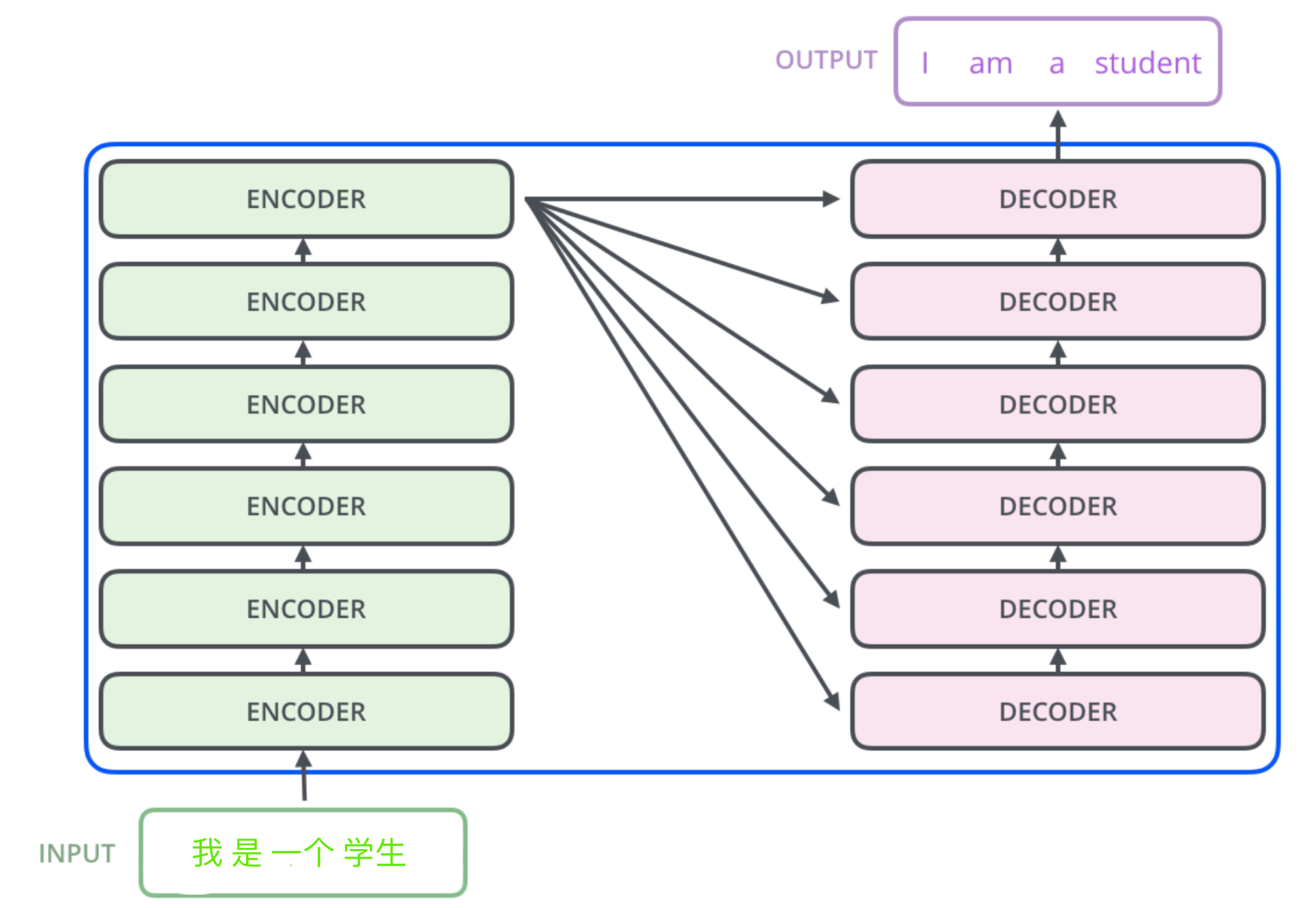
Decoder的代码主要结构:
|
1
2
3
4
5
6
7
8
9
10
11
12
|
# Decoder部分class Decoder(nn.Module): """带mask功能的通用Decoder结构""" def __init__(self, layer, N): super(Decoder, self).__init__() self.layers = clones(layer, N) self.norm = LayerNorm(layer.size) def forward(self, x, memory, src_mask, tgt_mask): for layer in self.layers: x = layer(x, memory, src_mask, tgt_mask) return self.norm(x) |
Decoder子结构(Sub layer):
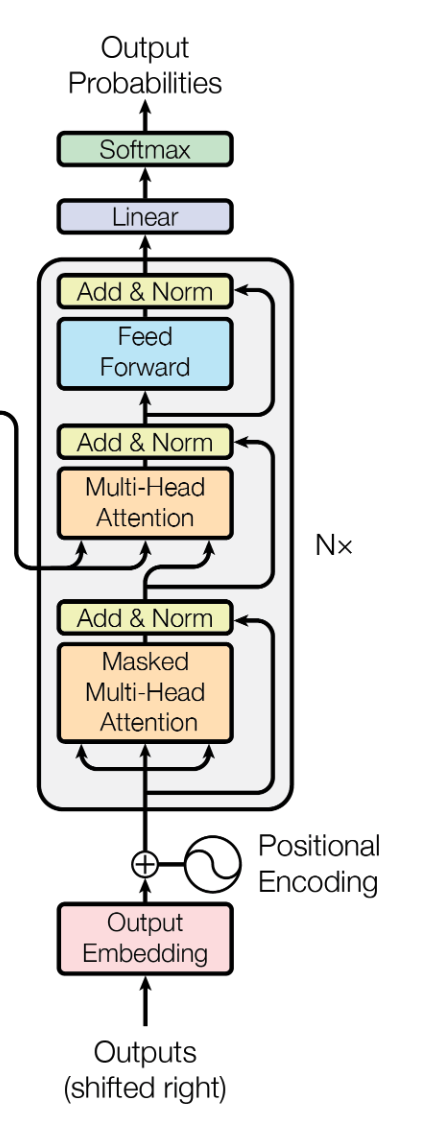
Decoder 也是N=6层堆叠的结构。被分为3个 SubLayer,Encoder与Decoder有三大主要的不同:
(1)Decoder SubLayer-1 使用的是 “Masked” Multi-Headed Attention 机制,防止为了模型看到要预测的数据,防止泄露。
(2)SubLayer-2 是一个 Encoder-Decoder Multi-head Attention。
(3) LinearLayer 和 SoftmaxLayer 作用于 SubLayer-3 的输出后面,来预测对应的 word 的 probabilities 。
5.1 Mask-Multi-Head-Attention
|
1
2
3
4
5
6
7
8
9
10
|
tensor([[[1, 0, 0, 0, 0, 0, 0, 0, 0, 0], [1, 1, 0, 0, 0, 0, 0, 0, 0, 0], [1, 1, 1, 0, 0, 0, 0, 0, 0, 0], [1, 1, 1, 1, 0, 0, 0, 0, 0, 0], [1, 1, 1, 1, 1, 0, 0, 0, 0, 0], [1, 1, 1, 1, 1, 1, 0, 0, 0, 0], [1, 1, 1, 1, 1, 1, 1, 0, 0, 0], [1, 1, 1, 1, 1, 1, 1, 1, 0, 0], [1, 1, 1, 1, 1, 1, 1, 1, 1, 0], [1, 1, 1, 1, 1, 1, 1, 1, 1, 1]]], dtype=torch.uint8) |
|
1
2
3
4
5
6
7
8
|
def subsequent_mask(size): """ mask后续的位置,返回[size, size]尺寸下三角Tensor 对角线及其左下角全是1,右上角全是0 """ attn_shape = (1, size, size) subsequent_mask = np.triu(np.ones(attn_shape), k=1).astype('uint8') return torch.from_numpy(subsequent_mask) == 0 |
5.2 Encoder-Decoder Multi-head Attention
|
1
2
3
4
5
6
7
8
9
10
11
12
13
14
15
16
|
class DecoderLayer(nn.Module): "Decoder is made of self-attn, src-attn, and feed forward (defined below)" def __init__(self, size, self_attn, src_attn, feed_forward, dropout): super(DecoderLayer, self).__init__() self.size = size self.self_attn = self_attn self.src_attn = src_attn self.feed_forward = feed_forward self.sublayer = clones(SublayerConnection(size, dropout), 3) def forward(self, x, memory, src_mask, tgt_mask): "将decoder的三个Sublayer串联起来" m = memory x = self.sublayer[0](x, lambda x: self.self_attn(x, x, x, tgt_mask)) x = self.sublayer[1](x, lambda x: self.src_attn(x, m, m, src_mask)) return self.sublayer[2](x, self.feed_forward) |
注意:self.sublayer[1](x, lambda x: self.src_attn(x, m, m, src_mask)) 这行就是Encoder-Decoder Multi-head Attention。
query = x,key = m, value = m, mask = src_mask,这里x来自上一个 DecoderLayer,m来自 Encoder的输出。
5.3 Linear and Softmax to Produce Output Probabilities
这部分的代码实现:
|
1
2
3
4
5
6
7
8
9
10
11
|
class Generator(nn.Module): """ Define standard linear + softmax generation step。 定义标准的linear + softmax 生成步骤。 """ def __init__(self, d_model, vocab): super(Generator, self).__init__() self.proj = nn.Linear(d_model, vocab) def forward(self, x): return F.log_softmax(self.proj(x), dim=-1) |
在训练过程中,模型没有收敛得很好时,Decoder预测产生的词很可能不是我们想要的。这个时候如果再把错误的数据再输给Decoder,就会越跑越偏。这个时候怎么办?
(1)在训练过程中可以使用 “teacher forcing”。因为我们知道应该预测的word是什么,那么可以给Decoder喂一个正确的结果作为输入。
(2)除了选择最高概率的词 (greedy search),还可以选择是比如 “Beam Search”,可以保留topK个预测的word。 Beam Search 方法不再是只得到一个输出放到下一步去训练了,我们可以设定一个值,拿多个值放到下一步去训练,这条路径的概率等于每一步输出的概率的乘积。
6 Transformer的优缺点
6.1 优点
(1)每层计算复杂度比RNN要低。
(2)可以进行并行计算。
(3)从计算一个序列长度为n的信息要经过的路径长度来看, CNN需要增加卷积层数来扩大视野,RNN需要从1到n逐个进行计算,而Self-attention只需要一步矩阵计算就可以。Self-Attention可以比RNN更好地解决长时依赖问题。当然如果计算量太大,比如序列长度N大于序列维度D这种情况,也可以用窗口限制Self-Attention的计算数量。
(4)从作者在附录中给出的栗子可以看出,Self-Attention模型更可解释,Attention结果的分布表明了该模型学习到了一些语法和语义信息。
6.2 缺点
在原文中没有提到缺点,是后来在Universal Transformers中指出的,主要是两点:
(1)实践上:有些RNN轻易可以解决的问题transformer没做到,比如复制string,或者推理时碰到的sequence长度比训练时更长(因为碰到了没见过的position embedding)。
(2)理论上:transformers不是computationally universal(图灵完备),这种非RNN式的模型是非图灵完备的的,无法单独完成NLP中推理、决策等计算问题(包括使用transformer的bert模型等等)。
7 References
1 http://jalammar.github.io/illustrated-transformer/
2 https://zhuanlan.zhihu.com/p/48508221
3 https://zhuanlan.zhihu.com/p/47063917



 浙公网安备 33010602011771号
浙公网安备 33010602011771号